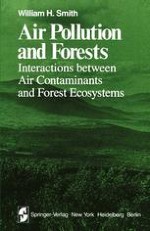1981 | OriginalPaper | Buchkapitel
Forest Stress: Influence of Air Pollutants on Phytophagous Forest Insects
verfasst von : William H. Smith
Erschienen in: Air Pollution and Forests
Verlag: Springer US
Enthalten in: Professional Book Archive
Aktivieren Sie unsere intelligente Suche, um passende Fachinhalte oder Patente zu finden.
Wählen Sie Textabschnitte aus um mit Künstlicher Intelligenz passenden Patente zu finden. powered by
Markieren Sie Textabschnitte, um KI-gestützt weitere passende Inhalte zu finden. powered by
Arthropods have roles of enormous importance in the structure and function of terrestrial ecosystems. Forest ecosystems, in particular, typically have large and diverse arthropod populations. The importance of pollinating (Chapter 7) and litter metabolizing (Chapter 8) species has already been introduced. The damaging influence of high population densities of certain insects can be very visible and cause widespread forest destruction; witness contemporary North American situations involving the Douglas fir tussock moth, the gypsy moth, the eastern spruce budworm, and the southern pine bark beetle. It is critically important, however, to keep in perspective that there is substantial evidence to support the notion that forest insects, even those that cause massive destruction in the short run, may play essential and beneficial roles in forest ecosystems in the long run. These roles may involve regulation of tree species competition, species composition and succession, primary production, and nutrient cycling (Huffaker, 1974; Mattson and Addy, 1975).
